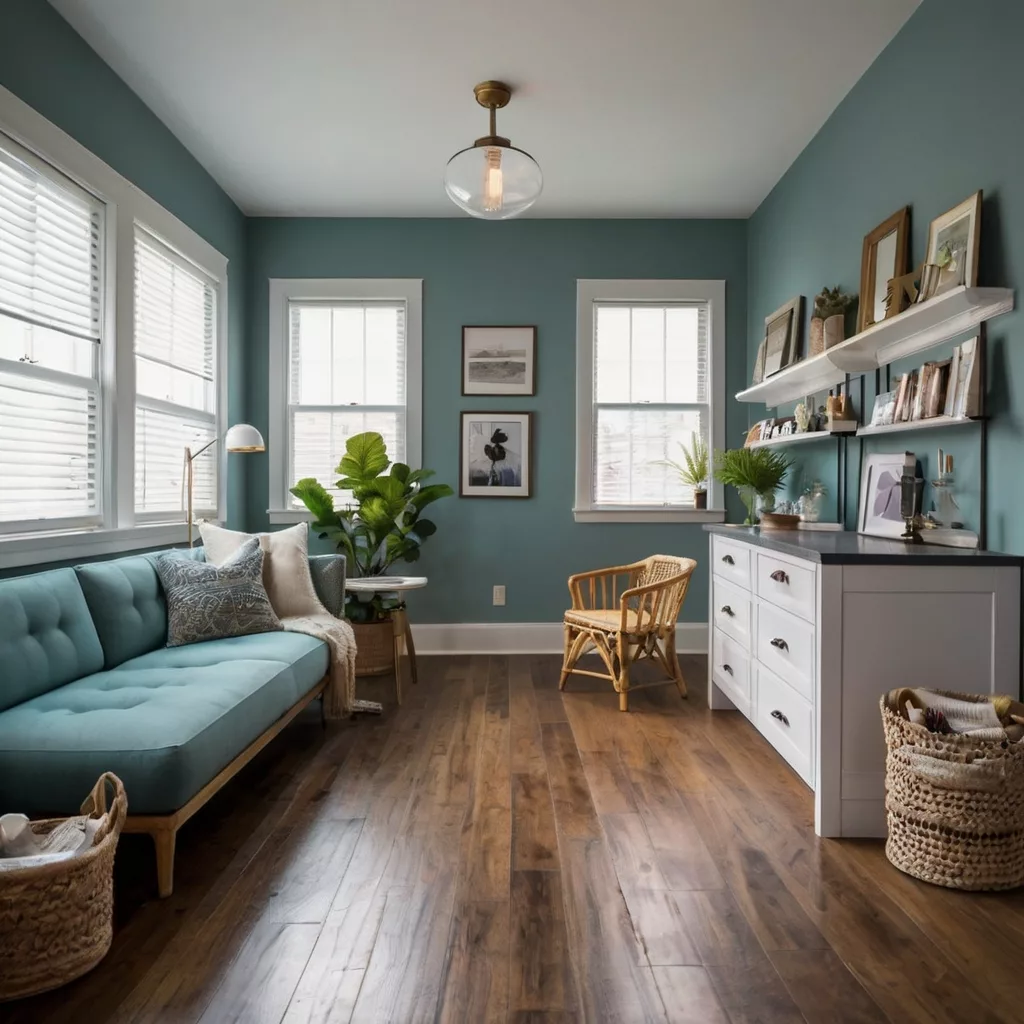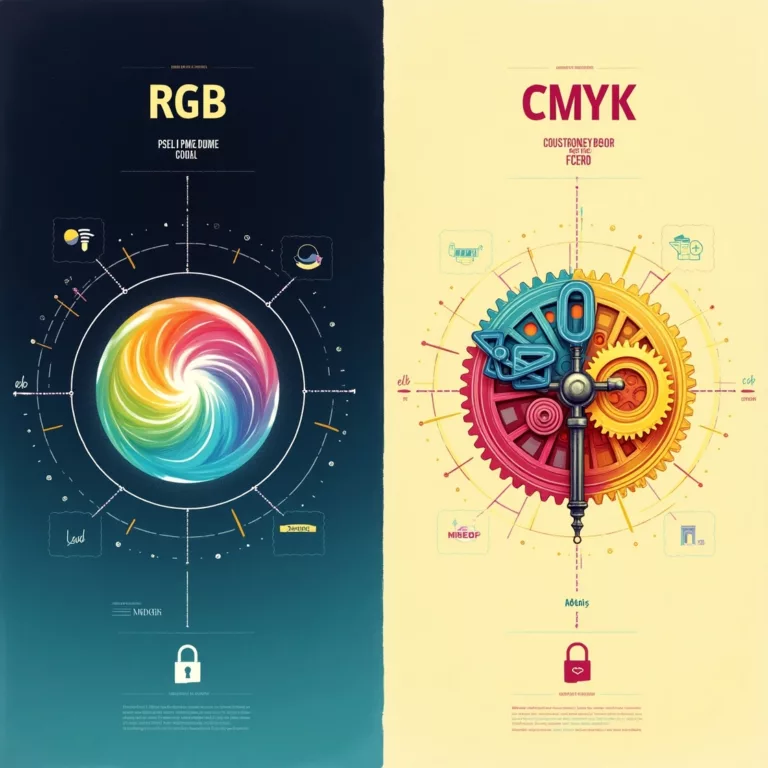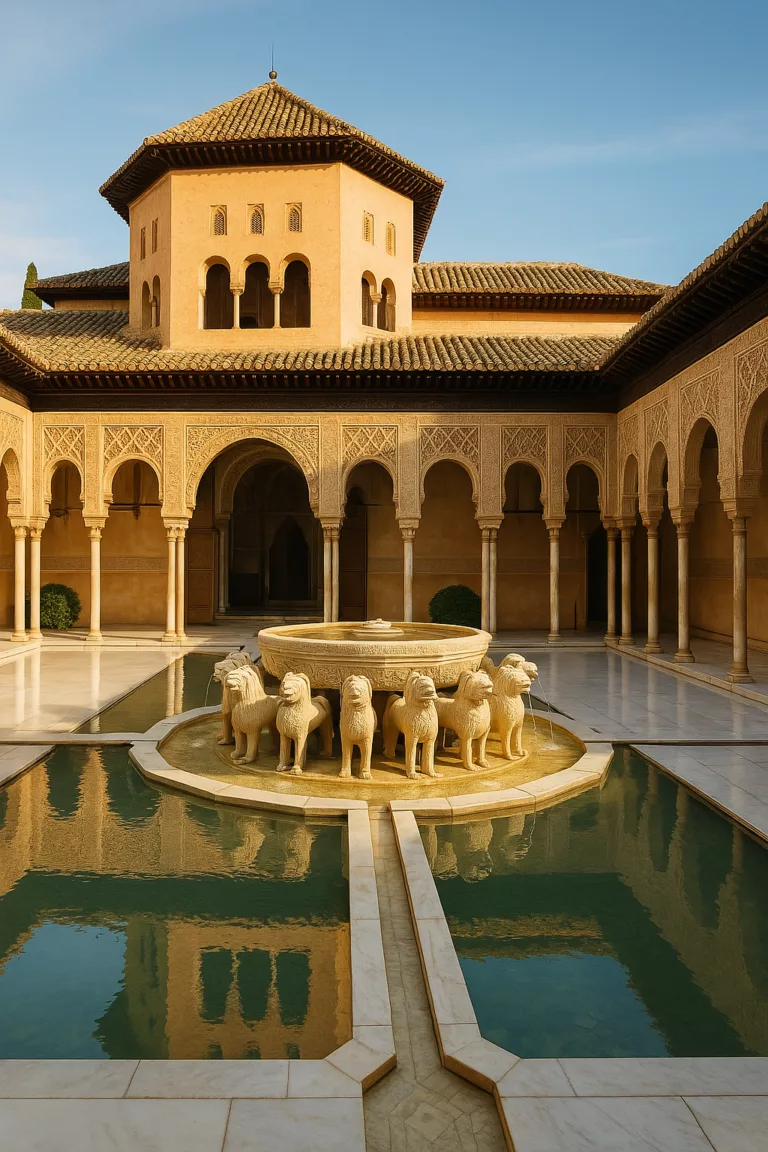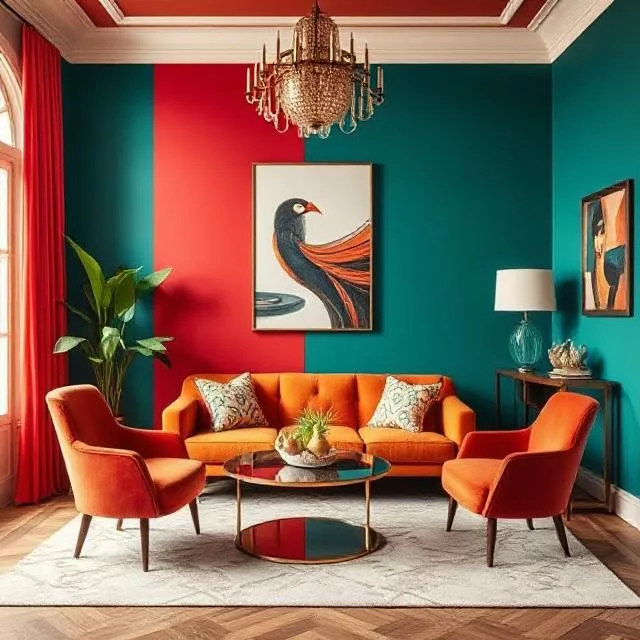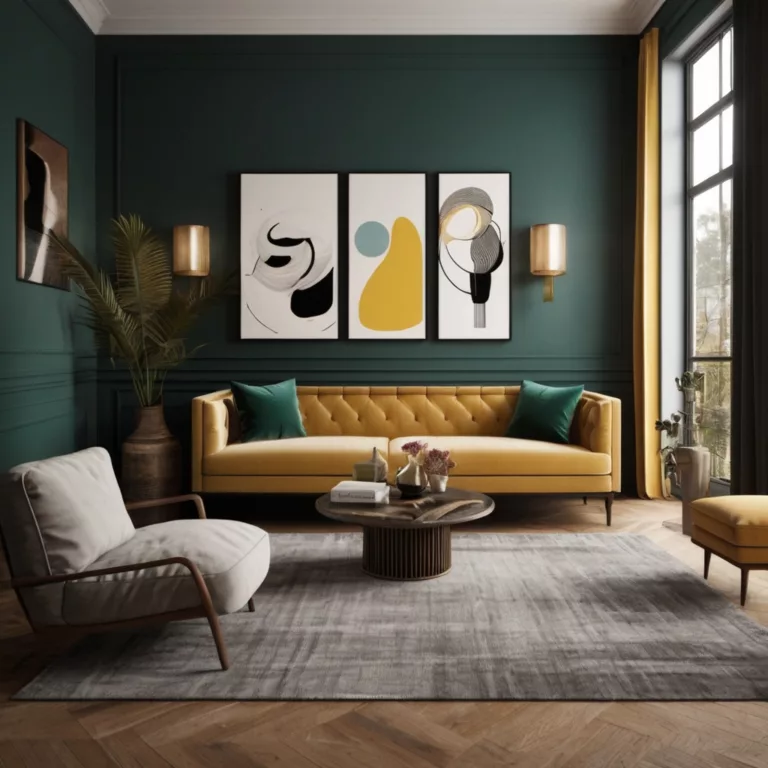Make Small Spaces Look Bigger with the Right Colors: The Complete Guide
Living in a small space doesn’t mean you have to feel cramped or confined. With strategic color choices and thoughtful design decisions, you can transform even the tiniest rooms into spaces that feel open, airy, and surprisingly spacious. This comprehensive guide explores how to make small spaces look bigger with the right colors, providing practical solutions for every room in your home.
Understanding How Color Affects Space Perception
Before diving into specific color recommendations, it’s important to understand the fundamental ways color influences our perception of space:
The Science Behind Color and Spatial Perception
Color doesn’t just affect our mood—it actually changes how we perceive physical dimensions. Certain colors advance (appear to come closer), while others recede (appear to move away). This optical illusion stems from how light wavelengths interact with our visual processing system.
Light colors reflect more light, making surfaces appear further away and expanding the perceived space. Dark colors absorb light, making surfaces appear closer and potentially shrinking the perceived dimensions of a room.
Cool colors (blues, greens, purples) tend to recede visually, creating a sense of distance. Warm colors (reds, oranges, yellows) typically advance, making walls feel closer.
The Color-Space Relationship: Key Principles
When trying to make small spaces look bigger with the right colors, keep these core principles in mind:
- Light Reflection Value (LRV): Higher LRV colors reflect more light and make spaces feel more open
- Color temperature: Cool colors create depth while warm colors create intimacy
- Contrast levels: Lower contrast schemes create visual flow and spaciousness
- Saturation impact: Less saturated colors appear to recede more than vivid ones
Best Colors to Make Small Spaces Look Bigger
White and Off-White: The Classic Space Enhancers
White remains the go-to choice for making small spaces look bigger—and for good reason. It reflects nearly 100% of light, instantly brightening rooms and pushing walls outward visually. However, not all whites are created equal:
- Pure bright white (like Benjamin Moore’s “Chantilly Lace” or Sherwin-Williams’ “Extra White”) maximizes the space-expanding effect but can sometimes feel cold
- Warm whites (like Benjamin Moore’s “Simply White” or Sherwin-Williams’ “Alabaster”) add subtle warmth while still maintaining an airy feeling
- Off-whites with subtle undertones can add dimension without sacrificing spaciousness
When using white, avoid stark, clinical feels by incorporating texture through natural materials, fabrics, and strategic decor elements.
Soft Neutrals: Sophisticated Space Expanders
Soft neutrals—including light grays, taupes, and beiges—create sophisticated, visually expansive spaces without the starkness of pure white:
- Light grays with blue undertones (like Benjamin Moore’s “Shoreline” or Sherwin-Williams’ “Silverpointe”) recede visually while adding subtle sophistication
- Warm greiges (gray-beige hybrids like Benjamin Moore’s “Revere Pewter” or Sherwin-Williams’ “Agreeable Gray”) create warmth without visual heaviness
- Soft taupes add richness while maintaining a space-enhancing lightness
These colors work particularly well in transitional or traditional spaces where white might feel too contemporary or stark.
Pale Blues and Greens: Creating Visual Depth
Light blues and greens can make small spaces look significantly bigger by leveraging the receding quality of cool colors:
- Pale sky blues (like Benjamin Moore’s “Breath of Fresh Air” or Sherwin-Williams’ “Topsail”) evoke the expansiveness of the sky
- Soft aquas blur the line between blue and green, creating versatile, space-enhancing backdrops
- Celery and sage greens add natural freshness while visually expanding walls
The subtle connection to nature that these colors provide also helps create a psychological feeling of openness and breathing room.
Delicate Pastels: Unexpected Space Creators
Used correctly, whisper-soft pastels can dramatically enhance perceived space:
- Blush pinks at very low saturation levels create warmth without advancing visually
- Pale lavenders with gray undertones add interest while maintaining visual distance
- Buttery yellows in very light tints bring cheerful energy without closing in walls
The key with pastels is choosing highly desaturated versions that are close to neutral on the color spectrum.
Room-by-Room Color Strategies for Small Spaces
Small Living Rooms: Creating Conversational Flow
Living rooms often present unique challenges because they need to accommodate multiple functions in limited square footage:
- Monochromatic color schemes in light neutrals create visual coherence across seating areas
- Matching wall and furniture colors (particularly with sofas) helps furniture blend rather than interrupt space
- Continuing the same wall color across adjacent spaces (like dining areas) visually removes boundaries
Consider painting built-ins and shelving the same color as your walls to prevent them from visually protruding into the room.
Tiny Bedrooms: Establishing Tranquil Space
Bedrooms benefit greatly from colors that both expand space and create restfulness:
- Soft blues (like Benjamin Moore’s “Glass Slipper” or Sherwin-Williams’ “Rainwashed”) combine space-enhancing properties with sleep-promoting qualities
- Whispery lavenders subtly recede while adding tranquility
- Warm whites with subtle undertones prevent the clinical feeling that can sometimes occur with bright whites
To maximize the space-enhancing effect, consider carrying your wall color onto built-in headboards or storage units.
Compact Kitchens: Maximizing Perceived Work Areas
Kitchens particularly benefit from strategic color choices that make tight work areas feel more functional:
- Light upper cabinets with slightly darker lowers create depth without sacrificing lightness
- Tone-on-tone approaches where cabinets and walls share similar hues reduce visual interruption
- Reflective surfaces in light colors multiply light and enhance spaciousness
For tiny kitchens, consider removing upper cabinet doors and painting the interiors the same color as your walls to create visual depth.
Small Bathrooms: Creating Spa-Like Openness
Bathrooms often benefit from colors that combine space enhancement with moisture-resistant properties:
- Soft celadon greens add freshness while making walls recede
- Pale blue-grays evoke water and sky while expanding visual boundaries
- Warm whites with minimal undertones maximize light reflection in spaces that are often windowless
Consider taking the same color from walls to ceiling in small bathrooms to eliminate the horizontal boundary that can make the ceiling feel lower.
Advanced Color Techniques for Small Spaces
Strategic Accent Walls: When and How
While conventional wisdom suggests avoiding dark colors in small spaces, strategically placed deep-colored accent walls can actually enhance spaciousness when used correctly:
- Dark end walls in rectangular rooms can make the space appear more square and balanced
- Rich colors behind key features (like beds or sofas) can create focal points that draw attention from the room’s size
- Deep tones on recessed walls can enhance architectural interest while creating perceived depth
The key is balancing darker accent walls with lighter adjacent walls and ensuring adequate lighting to prevent the dark color from absorbing too much light.
Color Drenching: Monochromatic Magic
“Color drenching”—using the same color across walls, trim, doors, and sometimes ceilings—is particularly effective for making small spaces look bigger:
- Eliminating visual boundaries between architectural elements creates uninterrupted visual flow
- Reducing contrast between surfaces prevents the eye from registering spatial limitations
- Creating cohesive color envelopes makes rooms feel intentionally designed rather than just small
This technique works particularly well with light-to-medium tones that have good light reflection values.
The Fifth Wall: Ceiling Color Strategies
Strategic ceiling colors can dramatically affect the perceived height and overall spaciousness of rooms:
- Slightly lighter versions of wall colors create subtle expansion without stark transitions
- Soft sky blues (like Benjamin Moore’s “Breath of Fresh Air”) evoke the unlimited height of the sky
- Glossy white finishes reflect light and create visual lift in very small spaces
For rooms with good natural light, consider pale blush tints on ceilings to create a subtle, flattering glow that enhances the sense of height.
Color Application Techniques That Maximize Space
Paint Finish Considerations
The sheen of your paint significantly impacts how color affects spatial perception:
- Matte finishes minimize surface imperfections but absorb more light
- Eggshell and satin finishes provide the ideal balance of light reflection and practicality for most small spaces
- Semi-gloss or high-gloss finishes on focal features can create subtle highlight points that add depth
In very small or poorly lit spaces, choosing paint with slightly higher sheen levels can enhance light reflection and spaciousness.
Transitional Color Techniques
Creating seamless transitions between spaces helps small homes feel more continuous and spacious:
- Ombré effects between adjacent rooms create subtle progression rather than abrupt changes
- Graduated tone shifts from lighter to slightly deeper versions of the same color add interest without spatial interruption
- Consistent undertones across different colors maintain visual flow throughout a home
These techniques are particularly effective in open-concept small spaces where traditional room divisions are minimal.
Visual Tricks with Color Blocking
Strategic color blocking can redirect attention and reshape spatial perception:
- Horizontal stripes on feature walls can make rooms appear wider
- Vertical color blocks create the illusion of higher ceilings
- Diagonal color transitions add dynamic energy while distracting from tight square footage
When using these techniques, maintain a limited palette with similar undertones to prevent visual chaos in small spaces.
Coordinating Other Elements with Space-Enhancing Colors
Furniture Colors for Small Spaces
Furniture selection and color significantly impact how spacious a room feels:
- Choosing furniture in colors similar to your walls reduces visual interruption
- Light-colored upholstery contributes to the overall lightness of the space
- Glass, acrylic, and reflective surfaces minimize visual weight
Consider furniture with exposed legs rather than skirted pieces to allow more floor visibility, which enhances spaciousness.
Flooring Choices That Complement Space-Enhancing Colors
Flooring creates the foundation for your color strategy:
- Light-toned woods or laminates enhance overall brightness
- Large-format tiles in light neutrals create the illusion of more floor area
- Continuous flooring between spaces eliminates visual boundaries
When possible, maintain the same flooring throughout adjacent spaces to create uninterrupted visual flow.
Window Treatments: Maximizing Light and Views
Windows are crucial for making small spaces feel connected to the outside world:
- Selecting window treatments in colors close to your wall color creates seamless transitions
- Mounting curtains closer to the ceiling and wider than the window frame expands perceived window size
- Using sheer fabrics in light colors maximizes natural light penetration
Consider leaving some windows entirely untreated (where privacy allows) to maximize the connection with exterior space.
Color Combinations That Expand Small Spaces
Tone-on-Tone Approaches
Layering different shades of the same color creates depth without division:
- Light greige walls with slightly deeper greige trim creates subtle definition
- Pale blue walls with whisper-blue ceilings enhances height while maintaining cohesion
- Ivory walls with cream-colored built-ins allows architectural features to register without creating choppy visuals
This approach works particularly well in traditional spaces where some color variation feels appropriate but contrast would be visually limiting.
Complementary Light Colors
Strategic use of complementary colors in very light versions can add interest while maintaining spaciousness:
- Pale lavender with whispery yellow accents creates subtle energy
- Light aqua with soft coral details evokes a spacious coastal feeling
- Barely-there sage with delicate pink accents brings in natural freshness
The key is using these combinations at very low saturation levels where they read almost as neutrals with just a hint of color personality.
Atmospheric Color Gradients
Creating subtle color progression from lighter to slightly deeper versions adds dimension to small spaces:
- Ombré effects on feature walls add visual interest without boundaries
- Graduated color progression between rooms creates flow through small homes
- Light-to-medium transitions within the same color family add depth without division
These techniques are particularly effective when trying to make small spaces look bigger while maintaining visual interest.
Common Color Mistakes in Small Spaces (And How to Avoid Them)
Dark Colors Without Balance
While deep colors can work in small spaces, they require careful balancing:
- Always pair darker colors with adequate lighting (natural or artificial)
- Balance deep tones with reflective surfaces and light accents
- Consider using deeper colors on smaller surface areas rather than entire rooms
When using darker colors, ensure they have depth and richness rather than flat, light-absorbing qualities.
High-Contrast Color Schemes
Stark contrasts create visual boundaries that can emphasize smaller dimensions:
- Reduce contrast between walls and trim in very small spaces
- Avoid sharp transitions between dark and light colors
- Use textural variation rather than color contrast to add interest
If contrast is desired, create it through small accessories that can be changed easily rather than permanent elements.
Competing Undertones
Clashing undertones create visual discord that makes spaces feel more confined:
- Analyze underlying hues in your neutrals (whether they lean warm or cool)
- Maintain consistent undertones across your main color selections
- Use color cards and samples in your actual space to identify undertone inconsistencies before committing
This issue is particularly common when combining whites and off-whites from different color families.
Implementation Guide: Bringing Color Theory to Life
Testing Colors Effectively
Before committing to colors for your small space:
- Paint large sample boards (at least 2’×2′) rather than small swatches
- View samples at different times of day to understand how lighting affects perception
- Test colors on different walls to see how they respond to varying light conditions
Remember that colors often appear more intense when covering entire walls than they do on small sample areas.
Professional Color Selection Resources
When making crucial color decisions for small spaces:
- Consider color consultation services offered by many paint retailers
- Explore curated small-space color palettes from major paint manufacturers
- Use digital visualization tools to preview colors in room settings similar to yours
Many paint companies now offer specific collections designed for small-space enhancement.
DIY Application Tips for Best Results
To maximize the space-enhancing effects of your chosen colors:
- Ensure thorough wall preparation to create smooth, light-reflecting surfaces
- Use high-quality paint with good coverage and accurate color representation
- Apply consistent, even coverage to prevent variations that can create visual interruption
Consider primer tinted to match your paint color for more accurate final results, particularly with lighter colors.
Real-Life Examples: Color Transformations in Small Spaces
Case Study 1: 500 sq ft Studio Apartment
A tiny urban studio was transformed using:
- Benjamin Moore’s “White Dove” on walls and ceiling
- Subtle color zone definition through accessory groupings
- Strategic use of mirrors to multiply light and color reflection
The result doubled the perceived space without sacrificing personality or warmth.
Case Study 2: Compact 900 sq ft Bungalow
This small historical home maintained character while gaining spaciousness through:
- Sherwin-Williams’ “Alabaster” as a consistent backdrop throughout main spaces
- Soft green-gray “Sea Salt” in the bedroom for tranquil space enhancement
- Original woodwork painted to match walls rather than standing in contrast
The home maintained its original charm while feeling significantly more spacious.
Case Study 3: Narrow 700 sq ft Townhouse
This challenging narrow layout was visually widened using:
- Horizontal striping techniques on one wall to enhance width perception
- Benjamin Moore’s “Classic Gray” as a space-enhancing neutral backdrop
- Strategic use of deeper accent colors on end walls to visually “push” them outward
The transformation created the impression of a much wider footprint without structural changes.
Conclusion: The Transformative Power of Color in Small Spaces
Making small spaces look bigger with the right colors isn’t just about painting everything white—it’s about understanding how color affects perception and applying that knowledge strategically. By considering light reflection, visual temperature, saturation levels, and thoughtful application techniques, you can transform even the most challenging small spaces into rooms that feel open, airy, and perfectly proportioned.
Remember that color is one of the most cost-effective design tools available, offering tremendous impact without requiring structural changes or significant investment. With the principles and techniques outlined in this guide, you can approach your small-space color decisions with confidence, creating environments that feel spacious, personal, and beautifully designed.
FAQs: Making Small Spaces Look Bigger with Color
Q: Can I use dark colors at all in a small space?
A: Yes, dark colors can be used strategically in small spaces—particularly on accent walls where they create depth, as backgrounds for shelving displays, or in rooms where you want to create an intimate, cozy atmosphere rather than maximize perceived space.
Q: What’s the difference between warm whites and cool whites for small spaces?
A: Warm whites have yellow or red undertones that create a softer, more welcoming feeling but may not maximize the space-expanding effect. Cool whites with blue or gray undertones typically create more perceived spaciousness but can sometimes feel less inviting without warming elements through furnishings and accessories.
Q: Should ceilings always be white in small spaces?
A: While white ceilings maximize light reflection, they’re not the only option. Painting ceilings the same color as walls can eliminate the visual boundary that defines room height. Alternatively, very pale tints of sky blue or blush can add subtle interest while maintaining height perception.
Q: How do I choose the right neutral for my small space?
A: Consider the fixed elements in your space (flooring, countertops, etc.), the quality of natural light (northern vs. southern exposure), and your personal color preferences. Test potential neutrals in large samples during different times of day to see how they respond to your specific lighting conditions.
Q: Can colorful accessories work in small spaces?
A: Absolutely. While walls and large furnishings might benefit from space-enhancing lighter hues, accessories provide the perfect opportunity to incorporate more saturated colors that add personality without compromising perceived spaciousness.

